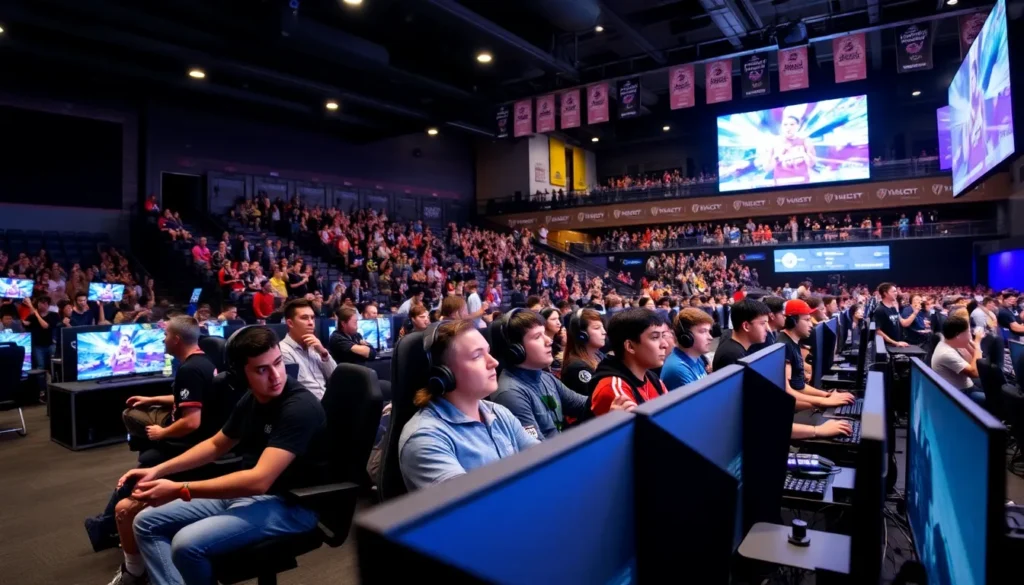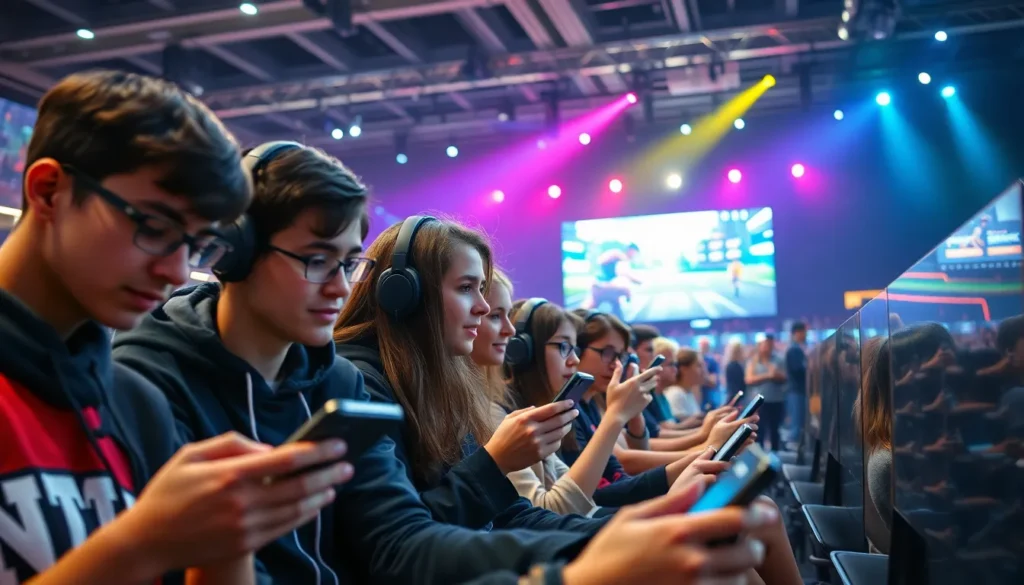Table of Contents
ToggleMobile esports is taking the gaming world by storm, and it’s about time we all hopped on this high-speed bandwagon. Gone are the days when serious gamers were tethered to bulky consoles or gaming PCs. Now, with just a smartphone, anyone can dive into thrilling competitions from the comfort of their couch—or even while waiting in line for coffee.
As mobile devices get more powerful and game developers roll out titles that rival traditional esports, the growth of mobile esports isn’t just a trend; it’s a revolution. With millions of players and fans worldwide, this dynamic field is transforming how people connect, compete, and celebrate their passion for gaming. So grab your phone, and let’s explore how mobile esports is reshaping the landscape and why it’s time to pay attention.
Overview Of Mobile Esports Growth
Mobile esports has experienced exponential growth in recent years, reshaping competitive gaming. Smartphones now serve as platforms for millions of players, contributing to a rapidly expanding audience. Transitioning from PCs and consoles, numerous gamers now favor mobile devices due to their accessibility and convenience.
Statistics reveal the scale of this growth; the global mobile gaming market reached over $175 billion in 2021. While traditional gaming segments continue to thrive, mobile esports constitutes an increasing percentage of overall gaming revenue. Game developers increasingly create high-quality titles, designed for competitive environments, that challenge traditional esports genres.
Tournaments centered on mobile games attract substantial viewership. For instance, the PUBG Mobile Global Championship drew millions of viewers during its 2020 season. Such events create excitement, drawing attention from sponsors and advertisers looking to engage with the burgeoning mobile gaming demographic.
Additionally, platforms such as Twitch and YouTube Gaming now prominently feature mobile esports content, further increasing visibility. This widespread exposure helps foster communities around mobile games, enhancing player engagement and participation.
In sum, the mobile esports industry demonstrates immense potential, driven by technological advancements and cultural shifts. The continuing integration of esports into popular culture only emphasizes its significance within the gaming landscape.
Factors Driving Mobile Esports Growth

Mobile esports growth stems from various factors that reshape the gaming landscape. Increased accessibility and technological advancements play critical roles in this evolution.
Increased Accessibility
Access to mobile esports expands as smartphones become ubiquitous. It allows players from different demographics to join the competitive gaming scene. Many individuals find gaming on mobile devices convenient, enabling play at any time and location. Schools and community centers increasingly support mobile esports initiatives, fostering local competitions. Platforms like Twitch and YouTube Gaming promote these events, creating a sense of community among players. With affordable internet access improving globally, more users can engage in streaming and participating in mobile esports. The appeal to new audiences continues to drive growth, bolstering the ecosystem further.
Technological Advancements
Technological advancements significantly enhance mobile gaming experiences. Improved processor capabilities allow for high-quality graphics and immersive gameplay, rivaling traditional consoles. Developers leverage innovative tools to create engaging esports titles, featuring competitive mechanics. Cloud gaming solutions enable seamless gameplay without heavy downloads or high-end hardware. Augmented reality (AR) and virtual reality (VR) technologies are starting to enter mobile esports, introducing unique experiences. Enhanced networking infrastructure supports smooth, lag-free play, making competitive matches more enjoyable. As advancements continue, the mobile esports landscape is set to evolve, attracting even more participants and viewers.
Popular Mobile Esports Titles
Mobile esports showcases a diverse array of titles that attract vast audiences and competitive players. High-quality games are rapidly evolving to meet the demands of this growing industry.
Notable Games
PUBG Mobile stands out as a leader in mobile esports, featuring battle royale gameplay that has captivated millions. League of Legends: Wild Rift offers a mobile adaptation of the popular MOBA, drawing in players with its strategic depth. Free Fire, another massively popular title, engages audiences through fast-paced gameplay and quick matches. Vainglory brings a blend of tactile precision and teamwork, highlighting the potential for serious competition. Call of Duty: Mobile combines classic FPS action with mobile accessibility, appealing to both casual and competitive gamers.
Emerging Trends
Augmented reality in games like Pokémon GO introduces innovative ways to experience mobile esports. Cloud gaming technology enables players to compete without high-end devices. Increasingly, teams are forming around popular titles, creating dedicated fan bases and fostering local communities. Sponsorship deals are on the rise, attracting major brands to the mobile esports sector. Streaming platforms are enhancing broadcasting quality, making it easier for fans to engage with their favorite games and players.
Impact On The Gaming Industry
Mobile esports significantly influences the gaming industry, shaping revenue streams and fostering community engagement.
Revenue Generation
The mobile gaming market surpassed $175 billion globally in 2021, with mobile esports capturing an increasing share of this revenue. Major tournaments like the PUBG Mobile Global Championship draw millions of viewers, attracting sponsorships from various brands. Prize pools for these competitions also reach substantial amounts, incentivizing players and teams to participate. Furthermore, streaming platforms such as Twitch and YouTube Gaming contribute to the financial landscape by enabling creators to monetize their content, thereby boosting the ecosystem. With the rise of mobile esports, revenue generation continues to expand, highlighting a lucrative avenue for developers, advertisers, and players alike.
Community Engagement
Mobile esports fosters a vibrant sense of community among players and fans. Schools and community centers organize local tournaments, allowing participants from diverse backgrounds to connect through competition. Gamers engage with one another using social media, sharing strategies and celebrating victories together. The growing popularity of mobile esports leads to dedicated fan bases surrounding titles such as Free Fire and Call of Duty: Mobile. Streaming events attract large audiences, strengthening community ties as fans support their favorite teams and players. In this landscape, community engagement plays a pivotal role, encouraging collaboration and fostering loyalty within the competitive gaming sphere.
Challenges Facing Mobile Esports
Mobile esports faces several significant challenges that hinder its potential growth. Competition with traditional esports presents a major hurdle. Players often favor established titles on PCs and consoles, hindering mobile platforms’ ability to attract dedicated audiences. Traditional esports, with larger events and higher prize pools, captures sponsors’ attention and funding. Specific mobile titles need to match this level of engagement to draw serious contenders.
Regulation and fair play also pose challenges. Ensuring a level playing field remains critical for mobile gaming’s credibility. Game developers must implement effective anti-cheat measures to prevent unfair advantages that can compromise competition integrity. As mobile esports continues to grow, establishing clear guidelines and standards is essential. These measures help create a safe environment for players and enhance the overall experience for fans and participants alike.
Future Prospects Of Mobile Esports Growth
Mobile esports growth continues to show significant potential, driven by innovative trends and technological advancements. Enhanced smartphone capabilities improve gaming experiences, allowing developers to create high-quality competitive titles. Major tournaments are becoming more common, drawing interest from global audiences. Increased viewer engagement on streaming platforms makes it easier for fans to connect with their favorite players and teams.
The rise of 5G technology plays a crucial role in this evolution. Improved connectivity enhances gameplay performance and reduces lag, creating a more seamless gaming experience. Many players are now able to participate in competitive gaming without the restrictions posed by slower internet speeds. With the wide adoption of 5G, mobile esports can capture even larger audiences.
Emerging markets present a valuable opportunity for growth as well. Countries with a growing middle class are increasingly investing in mobile devices and high-speed internet. This expansion allows more players to enter the competitive gaming scene and fosters diverse talent. Additionally, schools and community centers continue to support local tournaments, encouraging participation from a broader demographic.
Sponsorship and advertising opportunities within mobile esports show promising trends. As major brands recognize the value of this market, they invest more in partnerships with teams and events. Substantial prize pools resulting from sponsorship deals attract top talent and heighten competition. Moreover, collaborations between mobile esports and mainstream media create new avenues for exposure and growth.
Challenges persist, particularly regarding fair play and regulation. Effective anti-cheat measures are necessary to maintain integrity in competitions. Establishing clear guidelines can foster trust within the community and encourage player retention. As the mobile esports landscape evolves, addressing these challenges becomes essential for sustained growth and success.
Mobile esports is undeniably reshaping the gaming landscape. With its rapid growth and increasing popularity it’s becoming a significant player in the overall gaming industry. As smartphones continue to advance and become more accessible millions of players are stepping into competitive gaming. The rise of innovative technologies and the emergence of dedicated communities are further solidifying its place in the hearts of gamers.
While challenges exist mobile esports is poised for a bright future. The potential for new markets and sponsorship opportunities promises to attract even more players and fans. As the industry evolves it will be crucial to address issues of regulation and fair play to ensure a thriving environment for all participants. The journey ahead for mobile esports is exciting and full of possibilities.







